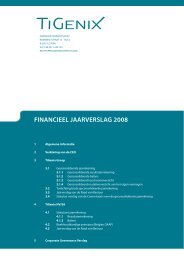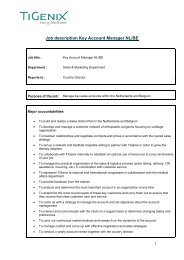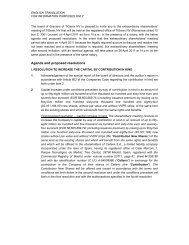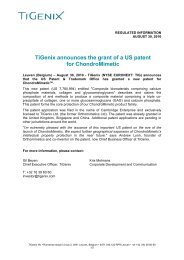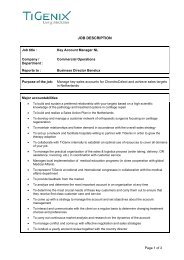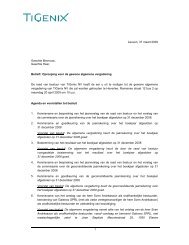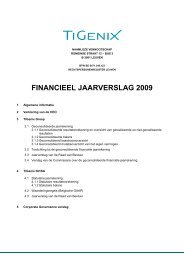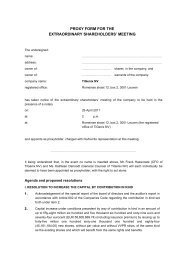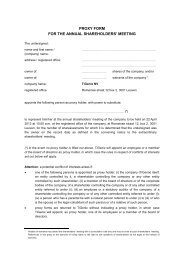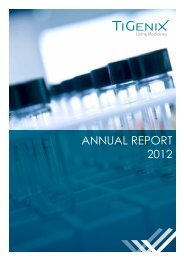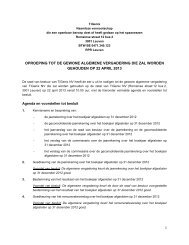ANNUAL FINANCIAL REPORT 2010 2010 - TiGenix
ANNUAL FINANCIAL REPORT 2010 2010 - TiGenix
ANNUAL FINANCIAL REPORT 2010 2010 - TiGenix
- No tags were found...
You also want an ePaper? Increase the reach of your titles
YUMPU automatically turns print PDFs into web optimized ePapers that Google loves.
6.9 CompetitionChondroCelect competitionThe market for the treatments of full-thickness (ICRS grade3-4) defects is highly fragmented and immature. There arecurrently no pharmacological products on the market or inadvanced stages of development that address the problem oflocalized cartilage defects. As described in section 6.4, currenttreatment options comprise a range of surgical treatments,conventional ACI-based therapies, and a number of cell-freeproducts. Consequently, obtaining accurate data that providea detailed breakdown of market share by product or treatmenttype is very difficult. In Europe and the US, debridement andmicrofracture are by far the most commonly-used procedures.In certain countries such as France, mosaicplasty.In the US, only one cell-based ACI product, Carticel®, fromGenzyme (Cambridge, MA), has obtained FDA-approval.Carticel is on the market in the US since 1997. In 2000, theindication for Carticel has been narrowed to second-linetreatment, for use in patients who have had an inadequateresponse to a prior arthroscopic or other surgical repairprocedure. Current sales are estimated to be in the order of USD35 million (representing an estimated 600-1000 procedures peryear). Several other companies in the United States are makingefforts to enter the cartilage repair market. ISTO Technologies(in partnership with Zimmer), is performing study to evaluatetheir surgical implantation technique and the quality of repairof cartilage defects with particulated juvenile cartilage inthe human knee joint. Prochon has reported to be in PhaseII of clinical development to evaluate BioCartII, a scaffoldseeded with autologous chondrocytes in combination withproprietary growth factors, against microfracture. Furthermore,HistoGenics, has started a Phase III clinical trial in the US withtheir autologous chondrocyte tissue implant NeoCart. Thisstudy is estimated to be completed in 2015. The Companycannot exclude that other companies may be active in thecartilage repair market as well.In Europe, where the barriers to entry for ACI servicesand cell-based products have so far been relatively low, anumber of smaller companies are active in the field. Most ACIcompanies are situated in Germany. With approximately 600 to700 procedures per year, Tetec, a subsidiary of the B. Braun,and Co.don are market leaders in Germany. Other companiesactive on the German market include CellGenix, Arthrokinetics,Biotissue Tech and Geistlich. Other important ACI companiesactive in Europe are Genzyme (through the acquisitionof Verigen in 2005) with approximately 400 commercialprocedures per year, Anika Therapeutics (through theacquisition of Fidia in <strong>2010</strong>) with 200 to 300 commercialprocedures (mainly in Italy) and Cellmatrix with approximately100 commercial procedures in Scandinavia. Next to thesecompanies, there are a number of hospitals that produceautologous cartilage for their own patients 41 .Given the new regulatory framework for Advanced Therapyproducts, most of these companies are under pressure todemonstrate clinical efficacy in, preferably randomizedcontrolled trials, by the end of 2012 at the latest. Apart fromGenzyme (Verigen), for its MACI product (Phase III ongoing);Tetec, for its Novocart product (Phase III to be started) and TBFin France with Cartipatch (Phase III ongoing), these companieshave, to the best of the Company’s knowledge, not initiatedprospective, randomised, controlled clinical trials to validatetheir products.Alternative competition may come from cell-free productsthat also target the cartilage repair market, which will generallybe brought to market through the medical device regulatoryroute. Different smaller ACI companies such as BioTissue andArthroKinetics are considering to abandon the cell-basedroute and attempting to bring on-step, cell-free products tothe market through the CE-marking route in Europe. Depuy(a Johnson & Johnson company) is developing a one-stepenhanced microfracture product (CAIS) and is currentlyperforming a clinical trial in the US. Examples of othercompeting products are AMIC (Geistlich), a collagen membraneused in combination with microfracture and BST-Cargel(Piramal) a self-gelling gel, also for use in combination withmicrofracture.41 KBC Securities research, November 26, <strong>2010</strong>.129 •



